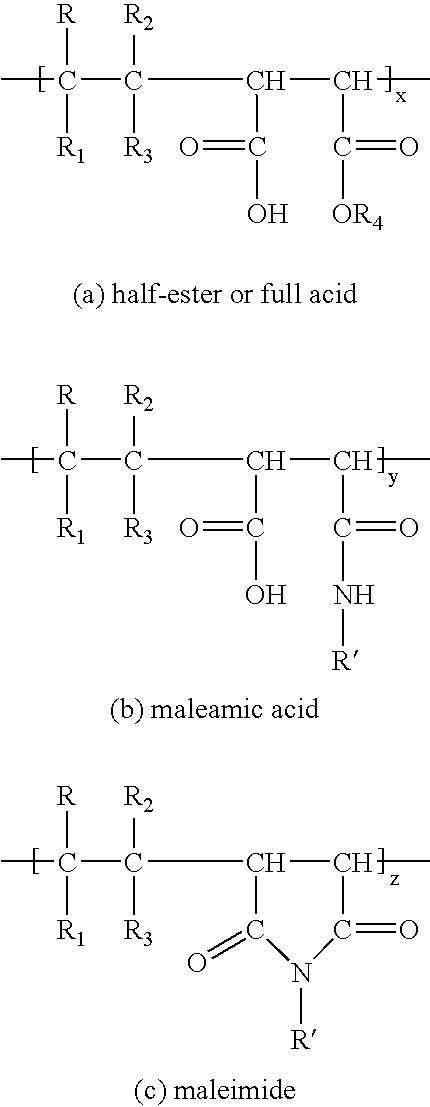Personal care products
a technology for personal care and products, applied in the field of personal care products, can solve the problems of brittleness of hair styling polymers, easy tearing of polymers when strained appreciably, and too soft for desirable hair styling
- Summary
- Abstract
- Description
- Claims
- Application Information
AI Technical Summary
Problems solved by technology
Method used
Image
Examples
example 1
Step 1
Preparation of Polymer (A)
[0032]The following were charged into a 2-liter, stainless steel high pressure reactor.
[0033]
P(maleic anhydride / isobutene) (Man)72.94g3-(dimethylamino) propylamine (50 mol % based on Man)24.17gJeffamine ® M-2070 (2 mol % based on Man)20.73g(M.W. 2,000, 70 / 30 EO / PO) (water soluble)Triethylamine (43 mol % based on Man) (Neutralizer)20.59gMethanol257.07g
[0034]The reactor was sealed, purged 3 times with N2 gas, and heating was begun according to the following heating profile.
[0035]
Ambient→ 90° C., 1½ hr. 90° C.→ 90° C., 2 hr. 90° C.→ 130° C., 1½ hr.130° C.→ 130° C., 8 hr.130° C.→ 35° C., 1 hr.
[0036]At the end of the heating cycle, the polymer product was obtained as a lightly viscous, yellow, clear solution; then it was flooded with water to give a viscous, hazy, yellow-colored solution.
Step 2
Mixing Polymer (A) with Carboxylic Acid Containing Polymer (B)
[0037]The polymer solution (A) was mixed with neutralized Carbopol®, a crosslinked acrylic acid polymer...
example 2
Step 1
[0038]The following reactants were added to a 2-liter pressure reactor:
[0039]
Poly(isobutylene / maleic anhydride)119.22gDimethylaminopropylamine39.51gJeffamine M-200542.35g(M.W. 2,000, 5 / 95 EO / PO (water-insoluble)Jeffamine M-207042.35g(M.W. 2,000, 70 / 30 EO / PO (water-soluble)Triethylamine31.30gEthanol510.20g
[0040]The reactor was sealed and purged with an inert gas. The following heating profile was initiated:
[0041]
Heat to 125° C. 4 hoursHold at 125° C.12 hoursCool to 35° C. 1 hour
[0042]After the heating profile was complete, the polymer solution was discharged from the reactor. The resultant material was a viscous, clear yellow solution. This material was laid down as a film and allowed to dry. A non-brittle film resulted which was water soluble. Exchanging ethanol for water gave a water-based polymer solution having similar properties to the ethanol-based material.
Step 2
[0043]This step was carried out as in Example 1 to provide similar results.
example 3
Step 1
[0044]The following reactants were added to a 2-liter pressure reactor:
[0045]
Poly(isobutylene / maleic anhydride)119.22gDimethylaminopropylamine39.51gJeffamine M-200584.70gTriethylamine31.30gEthanol510.20g
[0046]The reactor was sealed and purged with an inert gas. The following heating profile was initiated:
[0047]
Heat to 125° C. 4 hoursHold at 125° C.12 hoursCool to 35° C. 1 hour
[0048]After the heating profile was complete, the polymer solution was discharged from the reactor. The resultant product was a viscous, clear yellow solution. This material was laid down as a film and allowed to dry. A non-brittle film resulted. Exchanging with water gave a water-based polymer solution having similar properties to the ethanol-based material.
Step 2
[0049]This step was carried out as in Example 1 to provide similar results.
PUM
| Property | Measurement | Unit |
|---|---|---|
| carboxylic acid | aaaaa | aaaaa |
| mole ratio | aaaaa | aaaaa |
| toughness | aaaaa | aaaaa |
Abstract
Description
Claims
Application Information
 Login to View More
Login to View More - R&D
- Intellectual Property
- Life Sciences
- Materials
- Tech Scout
- Unparalleled Data Quality
- Higher Quality Content
- 60% Fewer Hallucinations
Browse by: Latest US Patents, China's latest patents, Technical Efficacy Thesaurus, Application Domain, Technology Topic, Popular Technical Reports.
© 2025 PatSnap. All rights reserved.Legal|Privacy policy|Modern Slavery Act Transparency Statement|Sitemap|About US| Contact US: help@patsnap.com



